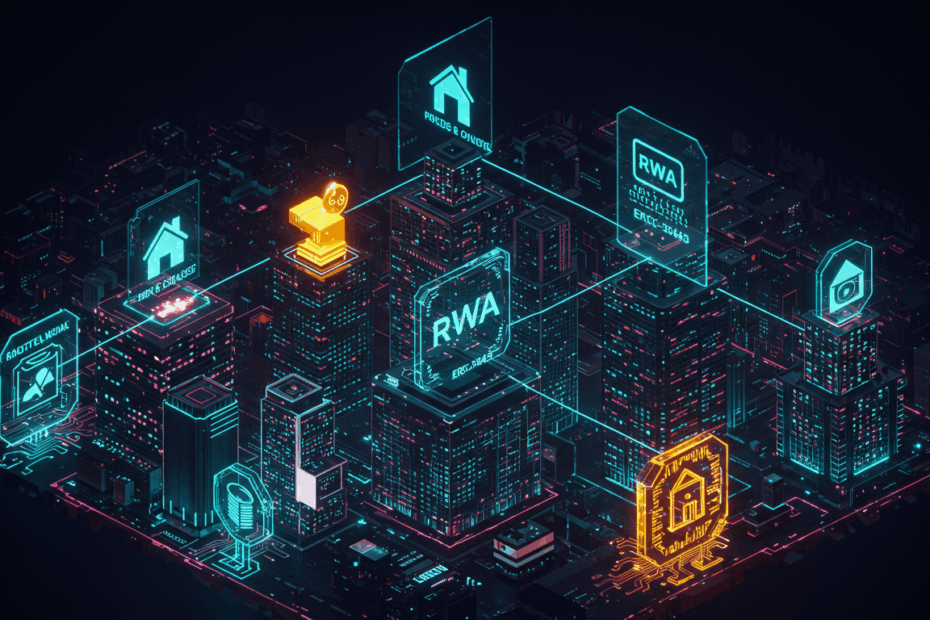Bridging Worlds: An Introduction to RWA, ERC-3643, and the Future of Tokenized Assets
John: Welcome back to our corner of the digital frontier. Today, we’re tackling a topic that’s quietly reshaping the foundations of both the Metaverse and traditional finance: Real-World Asset tokenization, or RWA. It’s about building a solid, trustworthy bridge between the physical items we own and their digital counterparts on the blockchain. This isn’t just theory anymore; it’s happening now, with market projections soaring into the trillions of dollars by 2030.
Lila: A bridge between physical and digital, John? That sounds huge. But for someone new to this, it also sounds a bit abstract. When you say “real-world assets,” are we talking about my coffee mug becoming an NFT? Or is it something more… substantial?
John: A fair question, Lila. While you could technically tokenize anything, the real focus is on high-value, traditionally illiquid assets. Think real estate, fine art, private company shares, or even barrels of oil. Tokenization is the process of creating a digital token that represents ownership of that asset on a blockchain (a decentralized, immutable digital ledger). This digital token is more than just a picture; it’s a secure, programmable certificate of ownership.
Lila: Okay, so it’s less about my coffee mug and more about a fraction of a skyscraper in Manhattan. That makes sense. But if you’re dealing with things that valuable, security and rules must be incredibly important. How do you stop just anyone from buying a piece of a regulated asset?
John: You’ve hit the nail on the head. That’s precisely where standards like ERC-3643 come in. It’s the star of our show today. It’s an open-source “rulebook” built on the Ethereum blockchain that ensures these digital tokens are handled with the same level of compliance and security as their real-world counterparts. It’s the technology that’s making big financial institutions finally comfortable with entering the world of digital assets.

Basic Information: What Are RWAs and ERC-3643?
Lila: Let’s break that down. You said ERC-3643 is a “rulebook.” Can you give me an analogy? If I’m buying a tokenized asset, what does this rulebook actually do for me?
John: An excellent way to think about it. Imagine a very exclusive, high-stakes club. ERC-20, the most common token standard, is like a general admission ticket. Anyone can hold it, anyone can trade it. It’s simple and universal. ERC-3643, on the other hand, is like a VIP membership card with a built-in background checker. Before you can even receive the card, the system verifies your identity and ensures you’re allowed to be in the club. And when you want to give your card to someone else, the system checks their credentials too. It enforces the club’s rules automatically.
Lila: So it’s a smart token! It knows who is allowed to hold it. That sounds like a game-changer for things like company shares, where you can’t just sell them to anyone off the street because of regulations.
John: Precisely. ERC-3643 embeds compliance directly into the token itself at the smart contract level. Key components include:
- Identity Management: It links a token to a verified, real-world identity.
- Transfer Controls: It can restrict transfers to only pre-approved, whitelisted wallets (digital accounts).
- Compliance Logic: It automates the enforcement of rules, such as KYC (Know Your Customer) and AML (Anti-Money Laundering) checks, and jurisdictional restrictions (preventing sales in certain countries).
This “permissioned” nature is what makes it so attractive for institutional-grade assets. It’s not about restricting access for the sake of it, but about making sure the digital world adheres to the laws of the real world.
Supply Details: Tokenizing Scarcity
Lila: This is fascinating. With cryptocurrencies like Bitcoin, we always talk about a fixed supply—only 21 million will ever exist. How does supply work for a tokenized asset? Is it also limited?
John: That’s a key distinction. The supply of a tokenized RWA is not artificially scarce; it’s directly tied to the underlying asset itself. If you tokenize a commercial building valued at $10 million, you might issue 10 million tokens, each representing $1 of equity. You can’t just create more tokens out of thin air, because each token is a legal claim on a piece of the tangible asset. The scarcity is real and verifiable.
Lila: So the total number of tokens is fixed by the asset itself. But does this mean I could buy just one $1 token and say I own a piece of that building? This sounds like it could democratize investment in a huge way.
John: It absolutely does. This is one of the most powerful aspects of RWA tokenization: fractional ownership. Historically, investing in a multi-million dollar office building or a rare Picasso painting was reserved for the ultra-wealthy. Tokenization breaks that barrier down. By dividing the asset into thousands or millions of digital shares, it opens the door for smaller investors to participate in markets they were previously locked out of. It turns illiquid, monolithic assets into liquid, divisible ones.
The Technical Mechanism: How Does ERC-3643 Actually Work?
Lila: Okay, John, let’s get a bit more technical. I’m picturing that “VIP membership card” again. How does the smart contract—the code on the blockchain—actually check someone’s credentials before allowing a transfer?
John: Great question. The magic of ERC-3643 lies in its elegant, modular architecture. It’s not one giant, complex contract but a system of interacting components. The two core pieces are:
- The T-REX (Token for Regulated Exchanges) Standard: This is the token itself. It contains the basic logic, but most importantly, it has a built-in function that checks with another contract before any action (like a transfer) is approved.
- The Identity Registry: This is a separate smart contract that acts as the “bouncer” or the gatekeeper. It maintains a secure, on-chain record of all the addresses that have been verified and are eligible to hold the token. It stores information like a user’s country, their accreditation status, and whether they’ve passed KYC.
When you try to send an ERC-3643 token, the token’s contract essentially calls the Identity Registry and asks, “Is the recipient on the VIP list?” Only if the registry gives a “yes” will the transfer go through. This separation of concerns makes the system both secure and flexible.
Lila: That’s brilliant. So the token doesn’t have to hold all the sensitive identity data itself, it just has to know who to ask. What happens if regulations change? Do you have to re-issue all the tokens?
John: Another excellent point, and one the designers anticipated. Because the Identity Registry is a separate contract, it can be updated by the issuer without ever touching the tokens themselves. For instance, if a new country is added to a restricted list, the issuer can simply update the rules in the registry. From that moment on, the tokens will automatically enforce the new rule. This adaptability is crucial for long-term assets that need to navigate an evolving legal landscape. It ensures the assets remain compliant over their entire lifecycle.
Lila: It seems like they’ve thought of everything. It’s not just about creating a token; it’s about managing its entire life in a regulated environment. This feels like the mature, grown-up version of crypto we’ve been hearing about.
John: That’s the perfect way to put it. It represents a fundamental shift from the “Wild West” ethos of early crypto to a new era of compliant, institutional-grade finance on the blockchain. It’s technology designed for trust and stability, which is exactly what you need when dealing with trillions of dollars in real-world value.

Team and Community: The Architects of Trust
Lila: With something this important, who is actually behind it? Is it one company that controls the standard?
John: That’s a crucial question in the decentralized world. ERC-3643, like all ERC (Ethereum Request for Comment) standards, is not owned by any single entity. It’s an open-source standard developed and refined by the global Ethereum community. It was proposed through the Ethereum Improvement Proposal (EIP) process, where developers submit ideas, gather feedback, and build consensus.
Lila: So anyone can contribute or use it? That’s powerful.
John: Yes, its open-source nature is a core strength. However, certain organizations have been instrumental in its development and adoption. The firm Tokeny Solutions is widely credited with pioneering the T-REX protocol and championing the ERC-3643 standard. They saw the need for a compliance-centric token framework early on and built the foundational architecture. Their work provided a robust starting point that the wider community could then build upon and scrutinize, leading to the secure and widely adopted standard we have today.
Lila: What about the community side? You mentioned platforms like Kadena are highlighting its importance. What role do they play?
John: Platforms like Kadena, a scalable proof-of-work blockchain, play a vital role in stress-testing, validating, and promoting these standards. When a major player like Kadena releases a report identifying ERC-3643 as the leading standard for compliant RWA tokenization, it sends a powerful signal to the market. It shows that the standard is not just theoretically sound but also practically applicable and ready for institutional use. This kind of research and validation from respected projects helps build the trust and momentum needed for widespread adoption. They become key evangelists and educators, showing the world what’s possible with this technology.
Use-Cases and Future Outlook: The Trillion-Dollar Opportunity
John: The potential applications here are vast and transformative. We’ve touched on a few, but let’s lay them out. The primary use-cases for RWA tokenization with ERC-3643 include:
- Real Estate: Fractionalizing ownership of commercial buildings, apartment complexes, or even vacation homes, making real estate investment more accessible and liquid.
- Private Equity and Venture Capital: Tokenizing shares in private companies allows for easier secondary trading and provides liquidity to early investors and employees, a historically difficult problem to solve.
- Debt and Credit: Tokenizing loans or corporate bonds can create more efficient, transparent, and globally accessible debt markets.
- Fine Art and Collectibles: A consortium could purchase a masterpiece by Monet and sell tokenized shares, allowing art lovers to own a piece of cultural history.
- Carbon Credits: Tokenizing carbon credits can create a more transparent and auditable market for environmental assets, which is crucial for fighting climate change.
Lila: Let’s walk through an example. Say my friends and I want to invest in a local commercial property. How would that work, step-by-step, using tokenization?
John: An excellent practical scenario. Here’s a simplified breakdown:
- Legal Structuring: First, a legal entity, like an LLC (Limited Liability Company), would be created to own the property. This is the crucial link to the real world; the LLC legally owns the building.
- Asset Valuation and Tokenization: The property is appraised. Let’s say it’s worth $1 million. The LLC then decides to issue 1 million tokens, where each token represents a 0.0001% ownership stake in the LLC, and by extension, the property.
- Choosing the Platform: They would use a tokenization platform that supports ERC-3643.
- Setting Compliance Rules: Through the Identity Registry, they would define the rules. For example, investors must be residents of a certain country and pass a KYC check.
- Investor Onboarding: You and your friends would go to the platform, create accounts, and submit your identity documents. Once verified, your digital wallets are “whitelisted” in the Identity Registry.
- The Sale: The token sale happens. You and your friends can now purchase the tokens directly with funds, and the ERC-3643 tokens are sent to your whitelisted wallets. You now provably own a fraction of the building.
- Ongoing Benefits: As the property generates rental income, the LLC can distribute profits directly to token holders’ wallets. If you want to sell your stake, you can trade your tokens with another whitelisted investor on a compliant secondary marketplace.
This process transforms a slow, paper-heavy transaction into a fast, transparent, and digitally native one.
Lila: That makes it so clear. The future outlook you mentioned—trillions of dollars—suddenly seems very plausible. Where do these numbers come from?
John: They come from major financial analysts. A widely cited report from the Boston Consulting Group (BCG) projects the tokenized asset market could reach $16 trillion by 2030. Think about the total value of all the world’s real estate, private equity, and debt. It’s a colossal number. Tokenizing even a small fraction of that represents a multi-trillion-dollar market. The Kadena report echoes this sentiment, seeing a path to an $11 trillion market by 2030, driven specifically by the need for compliant standards like ERC-3643. This isn’t a niche crypto trend; it’s the future of capital markets.

Competitor Comparison: Why Not Just Use an NFT?
Lila: Okay, so we have ERC-3643. But I’ve heard of other token standards. We mentioned ERC-20, the standard for most cryptocurrencies on Ethereum. And of course, there’s ERC-721 for NFTs (Non-Fungible Tokens). How is ERC-3643 different, and why is it better for this specific job?
John: That’s the critical question of using the right tool for the right job. Let’s compare them:
- vs. ERC-20 (Fungible Tokens): ERC-20 is the standard for interchangeable tokens, like digital currency. Each token is identical to the next. The problem is its “permissionless” nature. It has no built-in mechanism to control who can own or trade it, making it unsuitable for regulated assets like securities.
- vs. ERC-721 (Non-Fungible Tokens): ERC-721 is for unique, one-of-a-kind assets, like a digital piece of art or a collectible. While it represents uniqueness, it’s not designed for fractional ownership and also lacks the built-in compliance framework needed for financial assets. You can’t split an NFT into a million pieces easily.
- vs. ERC-1400 (Security Token Standard): This is a closer competitor. ERC-1400 is another standard designed for security tokens. It’s very comprehensive and powerful, but also very complex. Some developers find it bulky, trying to be a one-size-fits-all solution.
Lila: So what makes ERC-3643 the preferred choice in many of these new reports?
John: Its advantages lie in its design philosophy: simplicity, modularity, and focus. Instead of putting every possible feature into one contract like ERC-1400, ERC-3643 keeps the core token lightweight and delegates the complex identity and compliance logic to the separate Identity Registry. This makes it:
- More Flexible: Issuers can create and manage different rule sets in the registry without changing the token.
- More Efficient: Transactions can be cheaper (in terms of gas fees on Ethereum) because the token contract itself is simpler.
- Easier to Adopt: Its straightforward, focused approach makes it easier for developers and institutions to understand, audit, and implement.
It hits the sweet spot between the total freedom of ERC-20 and the heavy complexity of ERC-1400. It’s purpose-built for one thing and does it exceptionally well: compliant asset tokenization.
Risks and Cautions: Navigating the New Frontier
Lila: This all sounds incredibly promising, but it can’t be all smooth sailing. What are the risks or challenges we should be aware of?
John: Absolutely. As with any pioneering technology, there are significant considerations. The primary risks fall into three categories:
- Regulatory Uncertainty: While ERC-3643 is designed for compliance, the laws themselves are still evolving. Regulators in different countries are still figuring out how to classify and govern digital assets. A project that is compliant today might face new hurdles tomorrow. This is the biggest external risk.
- Smart Contract Vulnerability: The code is the law. While ERC-3643 is well-audited, any custom logic added by an issuer could potentially introduce bugs or security holes. A flaw in a smart contract could lead to catastrophic loss of funds, and there’s no central authority to reverse transactions.
- The Oracle Problem: This is a fundamental challenge in blockchain. How does the digital token reliably connect to the real-world asset? You need a trusted “oracle” (a secure data feed) to report on the asset’s condition, valuation, and legal status. If that oracle is compromised or provides bad data, the token’s value could be affected. Ensuring the integrity of this bridge is paramount.
Lila: That oracle problem sounds tricky. It’s like having a perfect digital contract that relies on a potentially flawed real-world report. And the regulatory side means that even with the best tech, you’re still at the mercy of government policy. It’s a reminder that this is still a very new space.
John: Precisely. It underscores the need for deep expertise, not just in technology but also in law and finance. The most successful RWA projects will be those that master all three domains. It’s why we’re seeing collaborations between tech firms, law firms, and financial institutions. No one group can do it alone.
Expert Opinions and Analyses
Lila: You’ve mentioned the Kadena report and BCG a few times. What’s the general consensus among experts? Are they all this bullish on RWA tokenization and ERC-3643?
John: The consensus is overwhelmingly positive, especially regarding the long-term potential. The key theme is the shift from “if” to “when.” For years, institutional finance has been watching crypto from the sidelines, intrigued by the efficiency but terrified by the lack of regulation. Reports from major players like Kadena, which highlight ERC-3643, are significant because they represent the industry identifying a viable path forward. They’re essentially saying, “Here is a standard that meets our requirements for security and compliance.”
Lila: So what’s the core driver for these big institutions? Is it just about making more money?
John: It’s more about fundamental efficiency and market expansion. Traditional finance is incredibly inefficient, bogged down by paperwork, intermediaries, and slow settlement times. A real estate transaction can take months. A stock trade settles in two days. On a blockchain, these can be settled in minutes, or even seconds. By tokenizing assets, institutions can:
- Reduce Costs: Automating processes with smart contracts cuts out many of the middlemen and administrative overhead.
- Increase Liquidity: They can turn illiquid assets on their balance sheets into tradable tokens, freeing up capital.
- Access Global Markets: A tokenized asset can be made available to a global pool of verified investors 24/7, breaking down geographical barriers.
ERC-3643 provides the compliant wrapper that allows them to unlock this efficiency without running afoul of regulators. It’s the key that unlocks the door.
Latest News and Roadmap
Lila: What’s happening right now in this space? Is adoption growing?
John: The momentum is accelerating rapidly. We’re seeing a wave of new platforms and projects launching that are built on or support ERC-3643. Hundreds of millions, and likely billions, of dollars in assets have already been tokenized using this standard, spanning real estate in the US to private credit funds in Europe. The latest news often revolves around major financial players announcing pilot programs or partnerships with tokenization platforms. For example, a large bank might partner with a firm like Tokeny to tokenize a bond as a proof-of-concept.
Lila: What about the roadmap for the technology itself? Can it be improved further?
John: Of course. The key area of development now is interoperability and cross-chain functionality. Right now, an ERC-3643 token lives on the Ethereum blockchain. But what if you want to trade it on another, faster, or cheaper blockchain like Kadena, Solana, or Avalanche? The roadmap for many of these protocols involves building secure “bridges” that allow these compliant tokens to move between different blockchain ecosystems without losing their security features. Achieving seamless cross-chain RWA markets is the next major frontier, and it will be a huge catalyst for growth.
Frequently Asked Questions (FAQ)
Lila: I have a few more questions that I imagine our readers might have. Let’s do a quick-fire round. First, is ERC-3643 only for Ethereum?
John: Originally, yes. It’s an Ethereum Request for Comment. However, its design is so effective that many other blockchains that are compatible with the Ethereum Virtual Machine (EVM) have adopted it. Furthermore, its principles are being used as a model for creating similar compliance standards on non-EVM chains like Kadena. The concept is portable.
Lila: Is investing in tokenized RWAs safe?
John: It’s safer than investing in unregulated crypto assets because of the built-in compliance and the link to a real-world asset. However, it still carries risks. You have investment risk (the value of the underlying asset could go down), technology risk (smart contract bugs), and regulatory risk. It’s not risk-free, but it’s designed to be risk-managed.
Lila: How do I buy a tokenized RWA?
John: You would typically go through a specialized RWA tokenization platform or a security token marketplace. You’ll need to create an account, go through a KYC/AML verification process, and then you can browse and invest in the available offerings once your wallet is whitelisted.
Lila: Does this mean the end of traditional finance?
John: Not the end, but a profound evolution. I see it as a convergence. We’ll see traditional financial institutions adopt this technology to upgrade their own infrastructure. It’s not about replacing Wall Street, but about putting it on a new, more efficient, and transparent set of rails. It’s a synthesis of the old and the new.
Related Links and Further Reading
John: For those who want to dive even deeper, the source is always the best place to start. You can explore the official proposals and community discussions around these standards.
- Official EIP-3643 Proposal
- Kadena’s Research and Perspectives on RWAs
- Tokeny Solutions Blog on Tokenization
Lila: This has been an incredibly insightful journey, John. You’ve taken a complex, alphabet-soup topic like “RWA and ERC-3643” and made it tangible. It’s clear this isn’t just another crypto trend, but a foundational layer for the next generation of the internet of value.
John: Well said, Lila. It’s about building a more open, efficient, and accessible financial system for everyone. The bridge between the real and digital worlds is being built, and it’s being paved with standards that prioritize trust and security. The future is tokenized.
Disclaimer: This article is for informational purposes only and does not constitute financial or investment advice. The digital asset market is volatile and involves significant risk. Please conduct your own thorough research (DYOR) and consult with a qualified professional before making any investment decisions.
